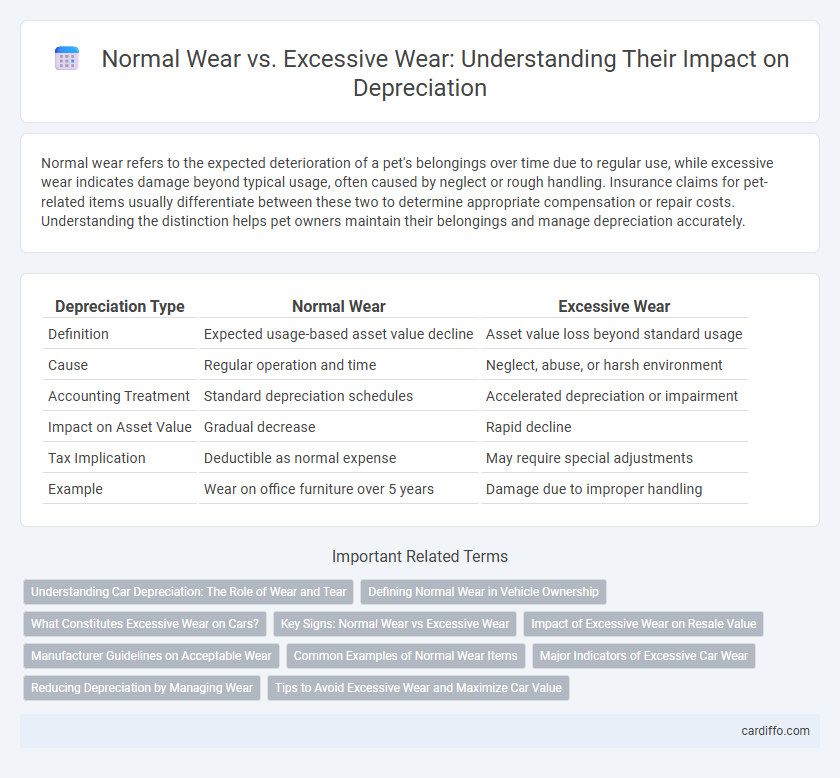Normal wear refers to the expected deterioration of a pet's belongings over time due to regular use, while excessive wear indicates damage beyond typical usage, often caused by neglect or rough handling. Insurance claims for pet-related items usually differentiate between these two to determine appropriate compensation or repair costs. Understanding the distinction helps pet owners maintain their belongings and manage depreciation accurately.
Table of Comparison
| Depreciation Type | Normal Wear | Excessive Wear |
|---|---|---|
| Definition | Expected usage-based asset value decline | Asset value loss beyond standard usage |
| Cause | Regular operation and time | Neglect, abuse, or harsh environment |
| Accounting Treatment | Standard depreciation schedules | Accelerated depreciation or impairment |
| Impact on Asset Value | Gradual decrease | Rapid decline |
| Tax Implication | Deductible as normal expense | May require special adjustments |
| Example | Wear on office furniture over 5 years | Damage due to improper handling |
Understanding Car Depreciation: The Role of Wear and Tear
Car depreciation is significantly influenced by the difference between normal wear and excessive wear; normal wear includes minor scratches and tire wear consistent with average use, while excessive wear involves damage such as deep dents, broken components, or interior stains that reduce the vehicle's market value more drastically. Understanding this distinction helps accurately assess a vehicle's depreciation rate, impacting resale value and insurance claims. Proper maintenance minimizes excessive wear, preserving the car's worth over time.
Defining Normal Wear in Vehicle Ownership
Normal wear in vehicle ownership refers to the expected deterioration that occurs from regular use over time, such as minor scratches, tire tread depletion, and slight interior fading. This standard depreciation aligns with typical driving patterns and maintenance practices, ensuring the vehicle's value decreases predictably without indicating neglect or damage. Excessive wear, by contrast, involves significant damage or neglect that surpasses this baseline, impacting resale value and repair costs.
What Constitutes Excessive Wear on Cars?
Excessive wear on cars includes damages beyond typical usage such as deep scratches, dents, rust, cracked windshields, and worn-out tires that compromise safety and aesthetics. These conditions accelerate depreciation by reducing the vehicle's resale value more significantly than normal wear, which consists of minor scuffs or light tire tread wear. Insurance companies and appraisers assess excessive wear by comparing the car's current state to standardized mileage and age expectations.
Key Signs: Normal Wear vs Excessive Wear
Normal wear is characterized by gradual deterioration consistent with regular use and the expected lifespan of assets, such as minor scratches, slight fading, and small dents on machinery or equipment. Excessive wear presents as severe damage or accelerated decline including deep corrosion, broken components, or significant structural damage that surpass typical usage patterns. Key signs to distinguish excessive wear include irregular maintenance history, operational anomalies, and physical evidence of neglect or misuse beyond standard depreciation parameters.
Impact of Excessive Wear on Resale Value
Excessive wear significantly reduces the resale value of an asset by accelerating depreciation beyond typical expectations, leading to a lower market price compared to normal wear. Assets showing signs of excessive wear often require costly repairs or refurbishment, further diminishing their attractiveness to buyers. This accelerated depreciation impacts financial statements by increasing expense recognition and reducing the asset's book value.
Manufacturer Guidelines on Acceptable Wear
Manufacturer guidelines on acceptable wear define the threshold between normal wear and excessive wear for assets, ensuring valuation accuracy during depreciation calculations. Normal wear aligns with expected usage over an asset's useful life, while deviations beyond specified limits trigger adjustments reflecting accelerated asset value loss. Adhering to these standards supports compliance with accounting regulations and enhances financial reporting precision.
Common Examples of Normal Wear Items
Common examples of normal wear items include worn tires, faded paint, and minor scratches on vehicles or equipment. These items naturally deteriorate over time due to regular usage and environmental exposure, reflecting standard depreciation processes. Understanding these typical wear patterns helps in accurately calculating asset value and setting appropriate maintenance schedules.
Major Indicators of Excessive Car Wear
Major indicators of excessive car wear include irregular tire tread wear, persistent oil leaks, and uneven brake pad deterioration. Other signs encompass sagging suspension components, frequent overheating, and diminished engine performance. Recognizing these factors helps differentiate normal wear from accelerated depreciation risks.
Reducing Depreciation by Managing Wear
Normal wear accounts for the expected loss of asset value due to routine use, while excessive wear significantly accelerates depreciation beyond standard rates. Implementing regular maintenance schedules and usage controls minimizes excessive wear, effectively reducing overall depreciation costs. Optimal asset management extends useful life, preserving residual value and enhancing financial efficiency.
Tips to Avoid Excessive Wear and Maximize Car Value
Regular maintenance and timely repairs prevent excessive wear on vehicle components, preserving depreciation value. Using protective measures such as seat covers, floor mats, and regular cleaning reduces interior deterioration. Monitoring tire pressure, rotating tires, and avoiding aggressive driving significantly extend the car's lifespan and resale value.
Normal Wear vs Excessive Wear Infographic

 cardiffo.com
cardiffo.com